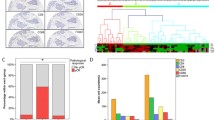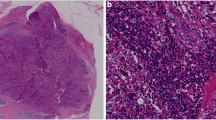Abstract
Purpose
Whether peripheral immune cell subsets can predict pathological complete response (pCR) in breast cancer patients remains to be elucidated. We aimed to dissect the relationship between peripheral immune cell subsets and pCR.
Methods
Two hundred and twenty-six eligible patients from two prospective clinical trials (SHPD001 and SHPD002) in China were randomly divided into a training cohort and a validation cohort. The breast cancer subtypes in this study included hormone receptor (HR)-positive/human epidermal growth factor receptor 2 (HER2)-negative (n = 95), HER2-positive (n = 100), and triple negative (n = 31) breast cancer. We defined the “Neo-Peripheral Adaptive Immune Score” for neoadjuvant chemotherapy (neoPAI Score) based on the percentages of CD4 + T cells, CD8 + T cells, B cells, and the CD4 + /CD8 + ratio in peripheral blood. We also evaluated the ability of the neoPAI Score derived from tumor-infiltrating immune cells (TIICs) to predict survival by employing The Cancer Genome Atlas-Breast Cancer (TCGA-BRCA) database.
Results
In the training cohort, multivariate analysis showed that HR status [odds ratio (OR) 0.325; 95% confidence interval (CI) 0.135–0.761; P = 0.010], HER2 status (OR 2.657; 95% CI 1.266–5.730; P = 0.011), Ki67 index (OR 3.191; 95% CI 1.509–6.956; P = 0.003), histological grade (OR 2.297; 95% CI 1.031–5.290; P = 0.045) and neoPAI Score (OR 4.451; 95% CI 1.608–13.068; P = 0.005) were independent predictors of pCR. In the validation cohort, histological grade (OR 3.779; 95% CI 3.793–1.136 × 103; P = 0.008) and neoPAI Score (OR 90.828; 95% CI 3.827–9.843 × 103; P = 0.019) were independent predictors of pCR. The Immune Model that integrated the neoPAI Score was more accurate in predicting pCR than the Clinical Model that exclusively contained clinicopathological parameters in both cohorts. In TCGA-BRCA database, the neoPAI Score constructed from TIICs can predict the progression-free interval (P = 0.048) of breast cancer.
Conclusion
The neoPAI Score defined by the percentages of peripheral immune cell subsets could be used as a potential biomarker for neoadjuvant chemotherapy efficacy.




Similar content being viewed by others
Data availability
Data are contained within the article, supplementary materials and from the corresponding author upon request.
References
Hammerl D, Smid M, Timmermans AM et al (2018) Breast cancer genomics and immuno-oncological markers to guide immune therapies. Semin Cancer Biol 52(Pt 2):178–188. https://doi.org/10.1016/j.semcancer.2017.11.003
Teshome M, Kuerer HM (2017) Breast conserving surgery and locoregional control after neoadjuvant chemotherapy. Eur J Surg Oncol 43(5):865–874. https://doi.org/10.1016/j.ejso.2017.02.002
Finn OJ (2012) Immuno-oncology: understanding the function and dysfunction of the immune system in cancer. Ann Oncol. https://doi.org/10.1093/annonc/mds256
Chen DS, Mellman I (2013) Oncology meets immunology: the cancer-immunity cycle. Immunity 39(1):1–10. https://doi.org/10.1016/j.immuni.2013.07.012
Palucka AK, Coussens LM (2016) The basis of oncoimmunology. Cell 164(6):1233–1247. https://doi.org/10.1016/j.cell.2016.01.049
de Melo GD, Cortes J, Curigliano G et al (2017) Tumor-infiltrating lymphocytes in breast cancer and implications for clinical practice. Biochim Biophys Acta Rev Cancer 1868(2):527–537. https://doi.org/10.1016/j.bbcan.2017.10.003
Denkert C, von Minckwitz G, Brase JC et al (2015) Tumor-infiltrating lymphocytes and response to neoadjuvant chemotherapy with or without carboplatin in human epidermal growth factor receptor 2-positive and triple-negative primary breast cancers. J Clin Oncol 33(9):983–991. https://doi.org/10.1200/JCO.2014.58.1967
Salgado R, Denkert C, Demaria S et al (2015) The evaluation of tumor-infiltrating lymphocytes (TILs) in breast cancer: recommendations by an International TILs working group 2014. Ann Oncol 26(2):259–271. https://doi.org/10.1093/annonc/mdu450
Savas P, Salgado R, Denkert C et al (2016) Clinical relevance of host immunity in breast cancer: from TILs to the clinic. Nat Rev Clin Oncol 13(4):228–241. https://doi.org/10.1038/nrclinonc.2015.215
Mahmoud SM, Paish EC, Powe DG et al (2011) Tumor-infiltrating CD8+ lymphocytes predict clinical outcome in breast cancer. J Clin Oncol 29(15):1949–1955. https://doi.org/10.1200/JCO.2010.30.5037
Nelson MA, Ngamcherdtrakul W, Luoh SW, Yantasee W (2021) Prognostic and therapeutic role of tumor-infiltrating lymphocyte subtypes in breast cancer. Cancer Metastasis Rev 40(2):519–536. https://doi.org/10.1007/s10555-021-09968-0
Kagamu H, Kitano S, Yamaguchi O et al (2020) CD4+ T-cell immunity in the peripheral blood correlates with response to anti-PD-1 therapy. Cancer Immunol Res 8(3):334–344. https://doi.org/10.1158/2326-6066.CIR-19-0574
Oh DY, Kwek SS, Raju SS et al (2020) Intratumoral CD4(+) T cells mediate anti-tumor cytotoxicity in human bladder cancer. Cell 181(7):1612–25.e13. https://doi.org/10.1016/j.cell.2020.05.017
Sledzinska A, Vila de Mucha M, Bergerhoff K et al (2020) Regulatory T cells restrain interleukin-2- and blimp-1-dependent acquisition of cytotoxic function by CD4(+) T cells. Immunity 52(1):151–66.e6. https://doi.org/10.1016/j.immuni.2019.12.007
Garaud S, Buisseret L, Solinas C et al (2019) Tumor infiltrating B-cells signal functional humoral immune responses in breast cancer. JCI Insight. https://doi.org/10.1172/jci.insight.129641
Tokunaga R, Naseem M, Lo JH et al (2019) B cell and B cell-related pathways for novel cancer treatments. Cancer Treat Rev 73:10–19. https://doi.org/10.1016/j.ctrv.2018.12.001
Varn FS, Mullins DW, Arias-Pulido H et al (2017) Adaptive immunity programmes in breast cancer. Immunology 150(1):25–34. https://doi.org/10.1111/imm.12664
Dzhandzhugazyan KN, Guldberg P, Kirkin AF (2018) Adoptive T cell cancer therapy. Nat Mater 17(6):475–477. https://doi.org/10.1038/s41563-018-0094-5
Restifo NP, Dudley ME, Rosenberg SA (2012) Adoptive immunotherapy for cancer: harnessing the T cell response. Nat Rev Immunol 12(4):269–281. https://doi.org/10.1038/nri3191
Zhou LH et al (2017) Weekly paclitaxel and cisplatin as neoadjuvant chemotherapy with locally advanced breast cancer: a prospective, single arm, phase II study. Oncotarget 8(45):79305–79314. https://doi.org/10.18632/oncotarget.17954
Newman AM, Liu CL, Green MR et al (2015) Robust enumeration of cell subsets from tissue expression profiles. Nat Methods 12(5):453–457. https://doi.org/10.1038/nmeth.3337
Liu J, Lichtenberg T, Hoadley KA et al (2018) An integrated TCGA pan-cancer clinical data resource to drive high-quality survival outcome analytics. Cell 173(2):400-416.e11. https://doi.org/10.1016/j.cell.2018.02.052
Sauerbrei W, Taube SE, McShane LM, Cavenagh MM, Altman DG (2018) Reporting recommendations for tumor marker prognostic studies (REMARK): an abridged explanation and elaboration. J Natl Cancer Inst 110(8):803–811. https://doi.org/10.1093/jnci/djy088
Pages F, Mlecnik B, Marliot F et al (2018) International validation of the consensus Immunoscore for the classification of colon cancer: a prognostic and accuracy study. Lancet 391(10135):2128–2139. https://doi.org/10.1016/S0140-6736(18)30789-X
Marliot F, Chen X, Kirilovsky A et al (2020) Analytical validation of the immunoscore and its associated prognostic value in patients with colon cancer. J Immunother Cancer. https://doi.org/10.1136/jitc-2019-000272
Park YH, Lal S, Lee JE et al (2020) Chemotherapy induces dynamic immune responses in breast cancers that impact treatment outcome. Nat Commun 11(1):6175. https://doi.org/10.1038/s41467-020-19933-0
Rutkowski J, Cyman M, Ślebioda T et al (2017) Evaluation of peripheral blood T lymphocyte surface activation markers and transcription factors in patients with early stage non-small cell lung cancer. Cell Immunol 322:26–33. https://doi.org/10.1016/j.cellimm.2017.09.007
Guo Z, Liang H, Xu Y et al (2017) The role of circulating t follicular helper cells and regulatory cells in non-small cell lung cancer patients. Scand J Immunol 86(2):107–112. https://doi.org/10.1111/sji.12566
Tada K, Kitano S, Shoji H et al (2016) Pretreatment immune status correlates with progression-free survival in chemotherapy-treated metastatic colorectal cancer patients. Cancer Immunol Res 4(7):592–599. https://doi.org/10.1158/2326-6066.CIR-15-0298
Yang J, Junnan Xu, Ying E, Sun T (2019) Predictive and prognostic value of circulating blood lymphocyte subsets in metastatic breast cancer. Cancer Med 8(2):492–500. https://doi.org/10.1002/cam4.1891
Axelrod ML, Nixon MJ, Gonzalez-Ericsson PI et al (2020) Changes in peripheral and local tumor immunity after neoadjuvant chemotherapy reshape clinical outcomes in patients with breast cancer. Clin Cancer Res 26(21):5668–5681. https://doi.org/10.1158/1078-0432.CCR-19-3685
Zhou H, Li G, Yin J et al (2021) Neoadjuvant chemotherapy alters peripheral and tumour-infiltrating immune cells in breast cancer revealed by single-cell RNA sequencing. Clin Transl Med 11(12):e621. https://doi.org/10.1002/ctm2.621
Malekzadeh P, Yossef R, Cafri G et al (2020) Antigen experienced T cells from peripheral blood recognize p53 neoantigens. Clin Cancer Res 26(6):1267–1276. https://doi.org/10.1158/1078-0432.CCR-19-1874
Li T, Zhao L, Yang Y et al (2021) T cells expanded from pd-1+ peripheral blood lymphocytes share more clones with paired tumor-infiltrating lymphocytes. Cancer Res 81(8):2184–2194. https://doi.org/10.1158/0008-5472.CAN-20-2300
Wu TD, Madireddi S, de Almeida PE et al (2020) Peripheral T cell expansion predicts tumour infiltration and clinical response. Nature 579(7798):274–278. https://doi.org/10.1038/s41586-020-2056-8
Gros A, Parkhurst MR, Tran E, et al (2016) Prospective identification of neoantigen-specific lymphocytes in the peripheral blood of melanoma patients. Nat Med 22(4):433-438. https://doi.org/10.1038/nm.4051Ò
Gu-Trantien C, Loi S, Garaud S et al (2013) CD4(+) follicular helper T cell infiltration predicts breast cancer survival. J Clin Invest 123(7):2873–2892. https://doi.org/10.1172/JCI67428
Hashemi V, Maleki LA, Esmaily M et al (2020) Regulatory T cells in breast cancer as a potent anti-cancer therapeutic target. Int Immunopharmacol. https://doi.org/10.1016/j.intimp.2019.106087
Funding
This work was supported by the Shanghai Sailing Program (Grant No. 22YF1424500), National Natural Science Foundation of China (Grant No. 82103695), Clinical Research Plan of Shanghai Hospital Development Center (Grant No. SHDC2020CR3003A), Science and Technology Commission of Shanghai Municipality (Grant No. 20DZ2201600), Shanghai Municipal Key Clinical Specialty, Shanghai Rising-Star Program (Grant No. 22QC1400200), Multidisciplinary Cross Research Foundation of Shanghai Jiao Tong University (Grant No. YG2019QNA28), Nurturing Fund of Renji Hospital (Grant Nos. PYIII20-09 and RJPY-LX-002), Clinical Research Innovation Nurturing Fund of Renji Hospital and United Imaging (Grant No. 2021RJLY-002).
Author information
Authors and Affiliations
Contributions
HW, YW, WY and JL: conceptualization, HW, YW and XS: methodology, YX, TY, JZ and YL: investigation, HW: formal analysis, HW and XS: writing—original draft preparation, HW, YW, WY and JL: writing—review and editing, YY, SX, LZ, WY and JL: supervision. All authors have read and agreed to the published version of the manuscript.
Corresponding authors
Ethics declarations
Conflict of interest
The authors declare no conflict of interest.
Additional information
Publisher's Note
Springer Nature remains neutral with regard to jurisdictional claims in published maps and institutional affiliations.
Supplementary Information
Below is the link to the electronic supplementary material.
Rights and permissions
Springer Nature or its licensor (e.g. a society or other partner) holds exclusive rights to this article under a publishing agreement with the author(s) or other rightsholder(s); author self-archiving of the accepted manuscript version of this article is solely governed by the terms of such publishing agreement and applicable law.
About this article
Cite this article
Wang, H., Sheng, X., Yan, T. et al. Neo-peripheral adaptive immune score predicts neoadjuvant chemotherapy for locally advanced breast cancer. Breast Cancer Res Treat 197, 343–354 (2023). https://doi.org/10.1007/s10549-022-06791-1
Received:
Accepted:
Published:
Issue Date:
DOI: https://doi.org/10.1007/s10549-022-06791-1




